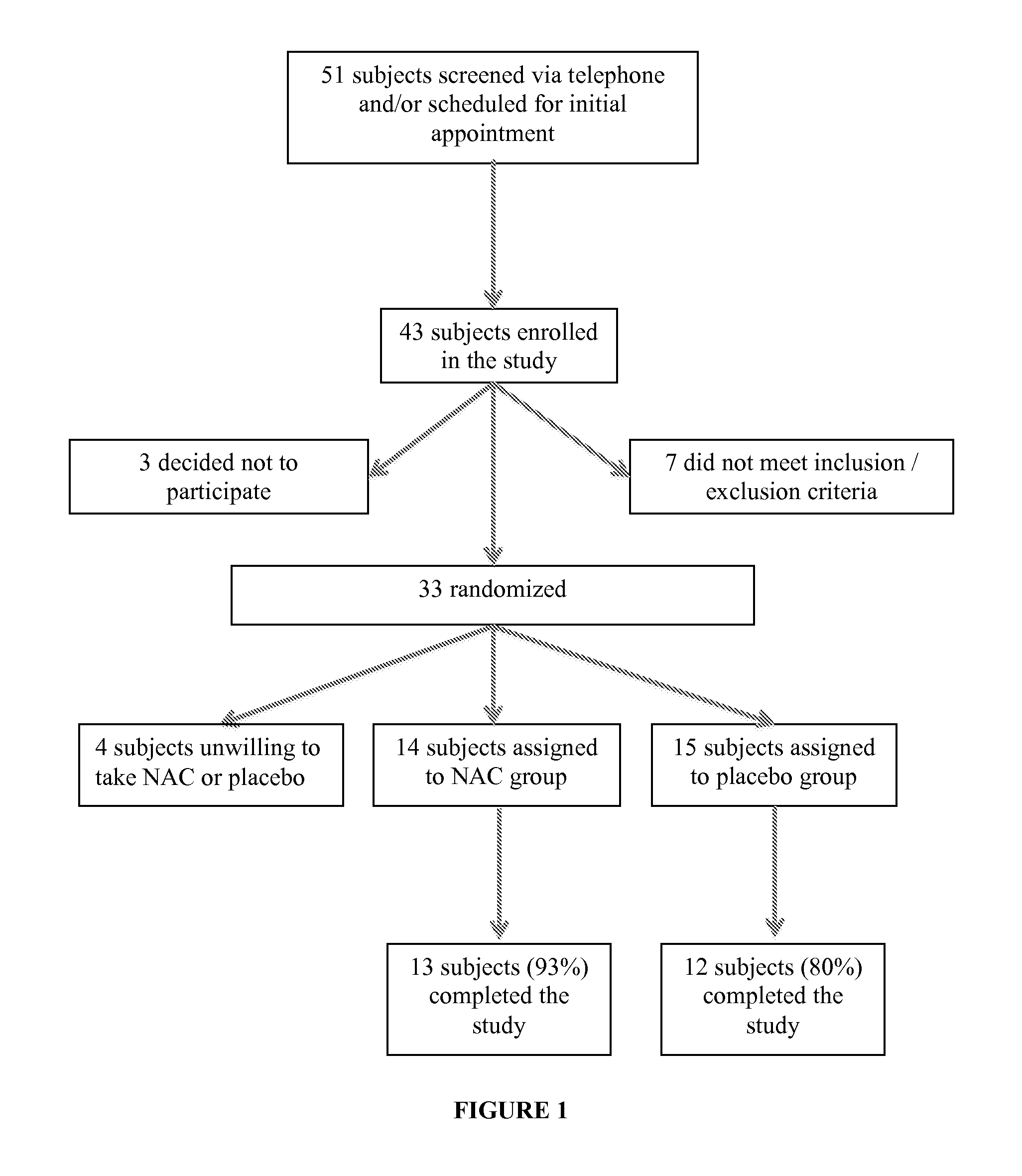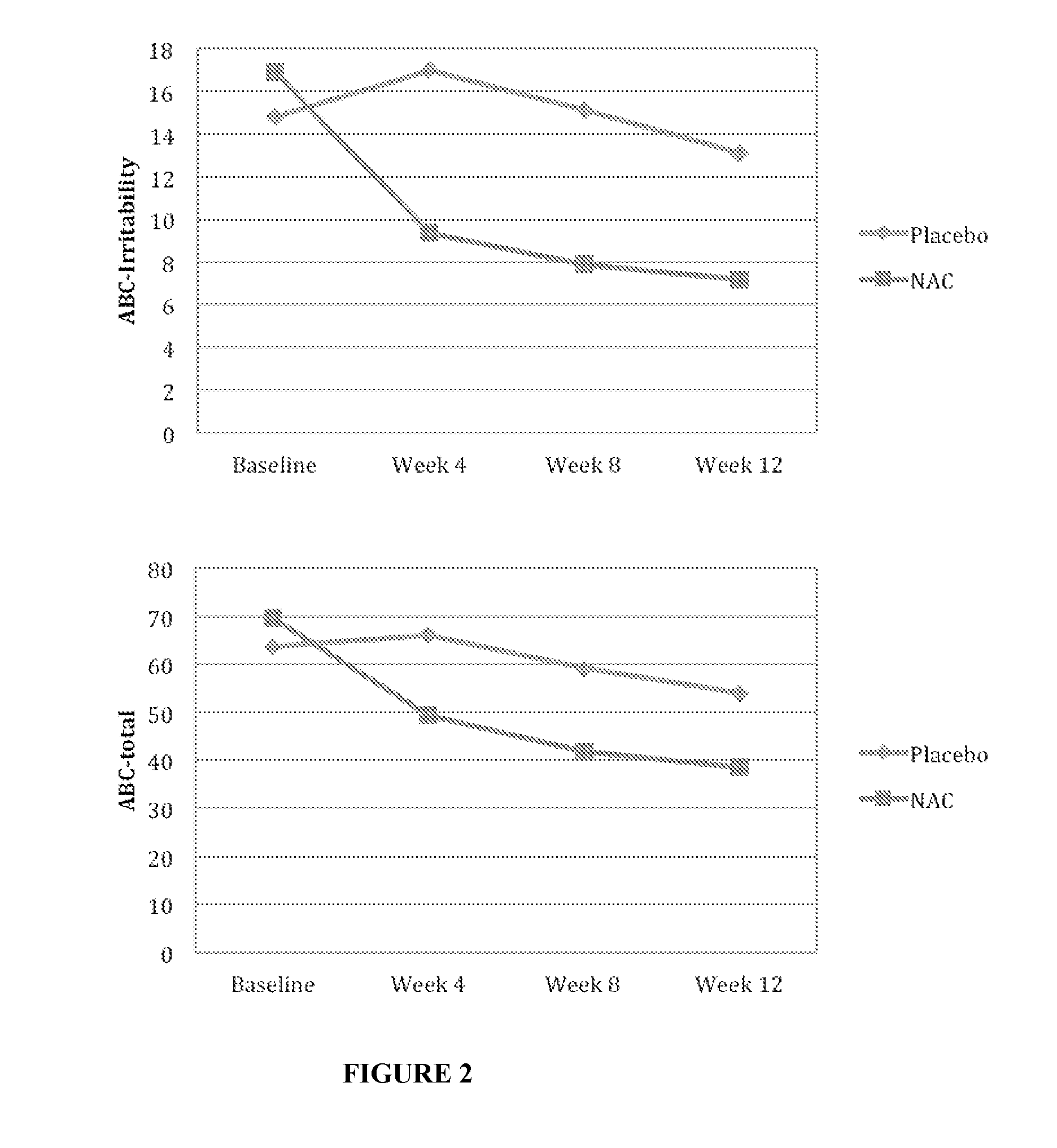Compositions and methods for treating autism and autism spectrum disorder
a technology for autism spectrum disorder and compositions, applied in the field of compositions and methods for treating autism and autistic spectrum disorders, can solve the problems of stereotypic or repetitive behavior, irritability of behavior, etc., and achieve the effects of avoiding oxidation, depleting glutathione (gsh) levels, and avoiding oxidation
- Summary
- Abstract
- Description
- Claims
- Application Information
AI Technical Summary
Benefits of technology
Problems solved by technology
Method used
Image
Examples
example 1
Study Population
[0162]FIG. 1 shows the patient disposition throughout the study. Fifty-one potential subjects inquired about the study. Forty-three of them signed an informed consent form. Seven did not meet the inclusion / exclusion criteria and 3 decided not to participate in the study before baseline measures were obtained. Thirty-three subjects representing 31 males and 2 females aged 3.2 to 10.7 years were randomized in the study. Fifteen were randomized to receive the composition containing NAC and eighteen were randomized to the placebo group. Four were unwilling to take the compound because of its taste (1 active and 3 placebo), so analyses were completed using data from the remaining subjects (NAC N=14, placebo N=15). There were no differences between the placebo group and the active group on any of the demographic and clinical baseline measures (Table 2). Mean age of subjects randomized in the NAC and placebo groups was 7.0±2.1 and 7.2±2.2 years, respectively. Twenty-five su...
example 2
Power for Primary Outcome Measures
[0163]Power to detect a N-acetylcysteine (NAC) treatment effect was examined using the observed sample size (29 total; 15 placebo, 14 NAC) and a four time point repeated measures ANOVA model. This model is typically conservative relative to the mixed effects regression models implemented in the present study which incorporate all available data and explicitly model relationships between time points. For this analysis, the correlation between repeated measures at baseline, week 4, week 8, and week 12 was conservatively estimated to be r=0.50. The observed correlations actually tended to be larger (r=0.43-0.86). Results indicated excellent power (0.89) to detect a medium effect size (f=0.25, d=0.50) for NAC treatment (a=0.05, two-tailed). Power to detect smaller treatment effects (f=0.10, d=0.20) was much weaker (0.20).
example 3
Behavioral Outcomes
[0164]
TABLE 3Treatment Responses of Participants with Autism Assignedto Receive N-Acetylcysteine (NAC) or PlaceboMean (SD) [Range]BaselineWeek 12PlaceboNACPlaceboNAC(n = 18)(n = 15)(n = 15)(n = 14)FpCohen's dABC total63.6 (28.5) 69.7 (24.7)53.9 (24.4)38.7 (24.1)4.06.010.63[28-123][15-104][14-114][3-85]ABC irritability14.8 (9.6) 16.9 (7.9)13.1 (9.9) 7.2 (5.7)6.80.72[5-41][1-27][4-41][0-18]ABC lethargy12.1 (7.8) 15.2 (9.5)8.3 (7.7)11.0 (9.4) 1.93.134−.32[1-24][2-31][1-23][0-32]ABC stereotypy8.9 (6.5) 9.1 (5.5)8.0 (7.0)5.6 (5.7)2.21.096.37[0-21][2-21][1-18][0-19]ABC23.8 (9.3) 23.4 (9.0)21.0 (11.5)12.4 (11.4)1.97.130.75hyperactivity[8-37][6-37][3-31][1-27]ABC4.1 (3.7) 4.9 (3.2)3.6 (3.6)2.5 (2.6)1.25.297.35inappropriate[0-11][0-11][0-11][0-7] speechCGI severity5.3 (0.8) 5.1 (0.7)4.9 (0.9)4.5 (0.8)1.73.170.47[3-6] [4-6] [3-6] [3-6] CGI——3.2 (0.9)2.9 (1.1)0.81.449.30improvement[2-5] [2-6] SRS total104.7 (28.1) 111.9 (28.3)98.5 (37.8)93.8 (26.7)2.36.141.14[48-158][64-150]...
PUM
| Property | Measurement | Unit |
|---|---|---|
| time | aaaaa | aaaaa |
| time | aaaaa | aaaaa |
| time | aaaaa | aaaaa |
Abstract
Description
Claims
Application Information
 Login to View More
Login to View More - R&D
- Intellectual Property
- Life Sciences
- Materials
- Tech Scout
- Unparalleled Data Quality
- Higher Quality Content
- 60% Fewer Hallucinations
Browse by: Latest US Patents, China's latest patents, Technical Efficacy Thesaurus, Application Domain, Technology Topic, Popular Technical Reports.
© 2025 PatSnap. All rights reserved.Legal|Privacy policy|Modern Slavery Act Transparency Statement|Sitemap|About US| Contact US: help@patsnap.com


